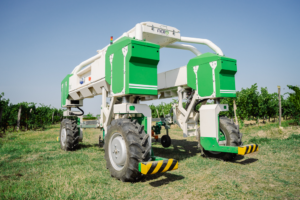Finding agricultural labor for tedious and monotonous tasks is a challenge, even for model farms. Weed control is time-consuming and cost-intensive work, particularly in special crops. Organic farming and restrictions on plant protection products also require effective, alternative solutions. In 2019, AIL’s Robotics Challenge laid the foundation for advancing agriculture with the help of fully autonomous systems. An exclusive dealer agreement with the French manufacturer of chopping robots, Naio Technologies, has been in place since April.

Naio Technologies is based in Toulouse, France. Packed with top technical expertise, the team of engineers in robotics, mechanics, and agronomy launched its vision in 2010. Hence, Naio Technologies has almost ten years’ experience and is the global market leader in agricultural robots.
In spring 2020, Naio Technologies and RWA concluded an exclusive dealer agreement. This will enable Austrian farmers to become fit for an automated future with the help of RWA.
Naio Technologies’ portfolio currently comprises three different machines. The autonomous chopping robot Oz makes it possible to remove weeds between rows that are spaced at least 65 cm apart. Oz is particularly useful in tree nurseries as well as in vegetable and spice farms where a performance of 1 ha per day is required. From 2021, Oz will be available to interested farmers for rent or purchase via RWA/AIL.
The Naio range features the Dino robot for bedding crops such as lettuce, leeks, and onions. It is suitable for row distances of 160-210 cm and can cover up to 5 ha per day. Dino makes it easy to hoe weeds between the rows and, in the case of certain crops, even hoes the rows themselves. Numerous tools can be attached to the basic vehicle. In 2021, RWA will enable interested farmers to see demonstrations of the Dino robot at work.
The third robot in the collection is the vineyard robot Ted, which can be used to mechanically control weeds below the vines and also, in particular, between the individual vines in the row. With its external width of 135 to 180 cm, a wide range of tools can also be attached to Ted. The electric power unit enables Ted to work for up to eight hours, during which it can cultivate up to 40 ha. Demonstrations of Ted can also be organized via RWA.
In 2021, AIL is looking forward to helping farmers to become more familiar with robotics and the automation of labor-intensive activities. The key arguments for the use of robots in agriculture include the resulting long-term independence from external labor, increased efficiency, and the specific solutions for organic farming, all of which offer Austrian farmers a viable perspective for the future. AIL is currently working together with the Lagerhaus Technik Center to create an attractive portfolio of services in the field of automation.
Image (c) Naio Technologies
